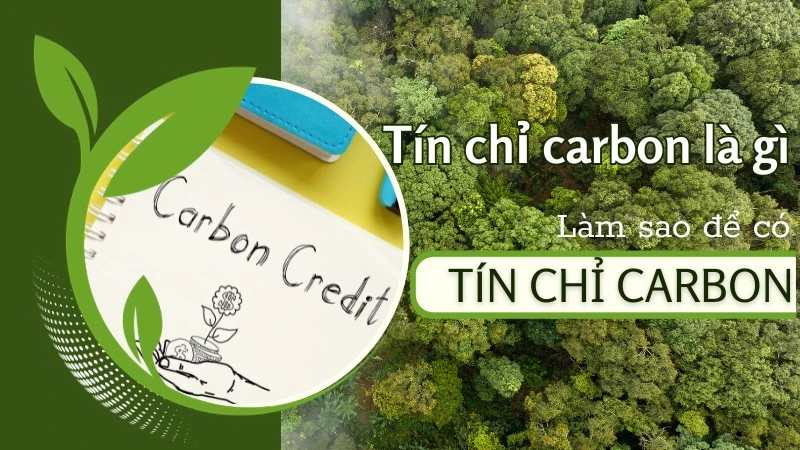What are carbon credits? How to get carbon credits?
What are carbon credits? How to get carbon credits?
20 March 2024
In the face of increasingly stringent requirements to reduce CO2 emissions, individuals, organizations, and enterprises are becoming more attentive to the issue of how to acquire carbon credits. In reality, these are valuable instruments that are traded in both domestic and international markets. Particularly, in the "battle" against climate change through measures to reduce greenhouse gas emissions and combat pollution, carbon credits are considered to be an exceedingly crucial tool! So what are carbon credits? And how does one acquire them? The article below by Minmax Green will assist you in finding answers to these questions!
What are Carbon Credits?
Before addressing how to acquire carbon credits, let us once again study in greater detail what this term means.
What are Carbon Credits? (Image source: Collected)
Carbon credits are a unit of measure and transaction, representing the right to emit a certain amount of CO2 (or an equivalent amount of other greenhouse gases such as CH4, NO2). These credits pertain to individuals, organizations, or a nation that generates these emissions either directly or indirectly. Carbon credits are a form of credit where individuals or organizations with net negative emissions can use these to trade with other entities with positive emissions, aiming to offset the emissions that they need to reduce. Each carbon credit is equivalent to one ton of CO2 (or an equivalent in other greenhouse gases).
More specifically, the carbon credit market originated from the Kyoto Protocol of the United Nations Framework Convention on Climate Change (adopted in 1997). As per the protocol, countries that have surplus emission allowances are permitted to sell or purchase from those who emit more or less than their commitment. And this trade is carried out through carbon credits.
The ultimate aim of establishing carbon credits and determining how to obtain them is to minimize greenhouse gas emissions, enhance sustainable economic development, and actively participate in the current fight against climate change. Consequently, carbon credits are regarded as a vital tool for governments and organizations to effectively manage greenhouse gas emissions. Today, carbon credits are traded internationally as a commodity. Negotiators at the Climate Summit (COP26 - held in November 2021) also agreed to create a global carbon credit trading market.
Why Should One Invest in Carbon Credits?
Investing in carbon credits offers a multitude of significant benefits, particularly in the context of global efforts to bolster activities against climate change. Here are some concrete reasons explaining why individuals and corporate entities are increasingly showing interest in how to secure carbon credits; and why they should consider investing in them:
Creation of Capital and Profit
The carbon credit market serves as a vital source of capital that aids businesses and the national economy in transitioning from 'brown' to 'green', reducing greenhouse gas emissions, and generating profits for both companies and the country at large. The sale of forest carbon credits or those associated with renewable energy sectors (wind, solar, etc.), energy conversion projects, waste recycling, agriculture, and forestry, can all result in substantial profits.
Carbon credits generate capital, profits (Image source: Collected)
Driving Emission Reductions
The carbon credit market is an optimal solution supporting enterprises as they pivot towards greener production processes. Additionally, there are green credit mechanisms, green bonds, tax incentives, etc., to assist in this transition.
Compliance with Regulations
In the future, mandated clients will include businesses and commercial facilities with greenhouse gas emissions exceeding legal limits. This will predominantly focus on heavy industrial sectors like steel production, cement, goods, chemicals, garments, etc.
Supporting the Fight Against Climate Change
The global carbon market is currently abuzz with the engagement of numerous conglomerates and big enterprises, all converging towards the goal of achieving net-zero emissions in alignment with global climate targets.
Combatting Climate Change (Image source: Collected)
Reflecting Market Trends
There is a growing number of investors and fund managers who focus on companies and projects that support emission reduction and sustainable development. Thus, investing in carbon credits not only helps to improve an enterprise's image and capital flow.
How Does One Acquire Carbon Credits?
In practice, carbon credits can be acquired in two common ways: the mandatory carbon market and the voluntary carbon market. Additionally, businesses can obtain carbon credits through actions like participating in forest conservation projects or embracing circular reforestation production processes. These efforts not only help to mitigate emissions but also enable individuals and enterprises to participate in the carbon market, opening up business opportunities and contributing to environmental conservation.
So, more specifically, how does one obtain carbon credits? Engaging in projects for afforestation and forest management since forests play an integral role in maintaining and balancing natural carbon levels. Protecting forests not only strives to preserve natural resources but also facilitates greater carbon absorption from the atmosphere. Therefore, afforestation and meticulous forest management stand as highly effective methods for acquiring carbon credits.
How to Obtain Carbon Credits? - Reforestation and Forest Management (Image source: Collected)
Buying and Trading Carbon Credits on Exchanges
How to secure carbon credits? One of the most commonplace methods is buying and trading them on exchanges. Carbon credit exchanges are platforms where individuals and organizations can buy and sell these credits according to specific regulations and standards. Moreover, these transactions not only allow businesses to solve the issue of how to acquire carbon credits but also promote transparency and reliability in emission reduction.
Participating in Circular Production Processes
Circular production involves optimizing resource use, recycling, saving energy, reducing waste, and aiming at carbon emission reduction activities. This approach also creates carbon credits and positively impacts the environment through sustainable production cycles.
Participating in Circular Production Processes Earns Carbon Credits (Image source: Collected)
Utilizing Renewable and Environmentally Friendly Energy
The use of renewable and sustainable energy sources (solar, wind, etc.) not only solves the problem of energy costs but also generates carbon credits.
In Conclusion
As it can be discerned, carbon credits are not merely a numerical value but represent the commitment of individuals, organizations, and businesses to the environment, contributing to the global fight against climate change. The above are some basic facts about carbon credits, as well as an answer to the query of how to secure them. By 2025, Vietnam is expected to commence trial operations of a carbon credit exchange, with official activities starting in 2028.
Let’s contact us
+84 931 861 313
68 Nguyen Hue, Ben Nghe Ward, District 1, Ho Chi Minh City, Vietnam
team@minmaxgreen.vn




